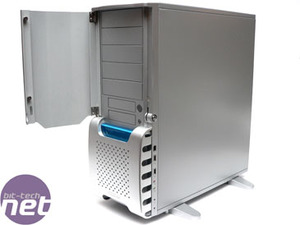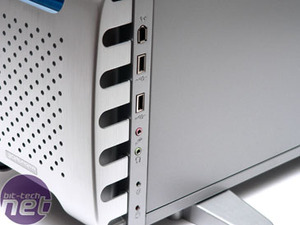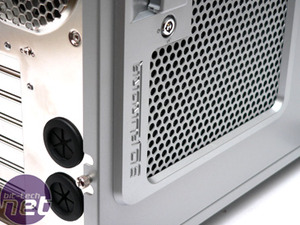
A Closer Look
Opening the door reveals (5) 5.25” and (2) 3.5” bays. You will also find the power and reset button along with one of the two locks for the case. The ability to lock the door not only prevents theft of drives but also even powering up your rig. The magnetic stays really grab the door when it closes. There is a slight indention on the right side of the case allowing you to open it. Or you can just grab the tab extension on the bottom of the door for those of us that are less dexterous.The bottom-front-right edge is home for: (2) USB 2.0 ports, (1) Firewire port, Mic In, Audio Out, as well as your power and hard drive LED’s.


Here you can see a better view of the side vent/window. This panel consists of two layers of mesh. The gray layer that matches the case color is a large, open mesh. Behind, is a finer black mesh that should help filter larger dust particles from entering the case but also keep unwanted fingers and pets out of your system. There is a second lock preventing the latch from opening the door. Yes, this box as two separate locks. Security must have been one of the key elements returned in Gigabyte’s research on desired case features. The side panel is additionally secured with three thumbscrews but those can be left off if desired. The panel latch does a sufficient job of securing the door without them and makes for easier access to your system if you are the type of user that needs convenient and routine access to the insides of your system.
The back features yet another nice element. Seen here in the bottom right are two ports with grommets for routing water cooling lines. We’ll get into that more in a bit. These allow for a safer way of routing your water lines into your case from an external cooling device than the typical PCI slot solution. There is less chance of damage to the tubing this way. The pie-cut flaps allow for securing tubing of varying diameter as well.


MSI MPG Velox 100R Chassis Review
October 14 2021 | 15:04








Want to comment? Please log in.